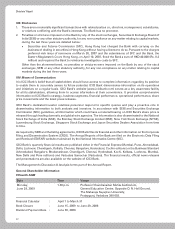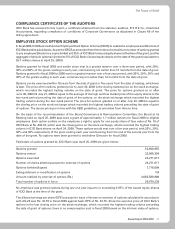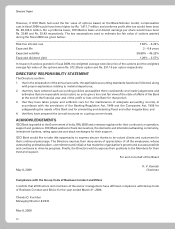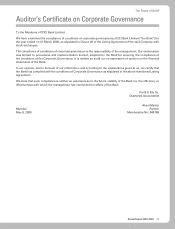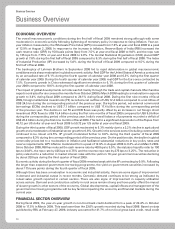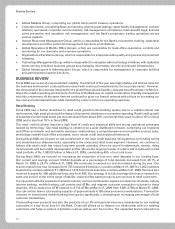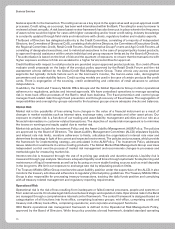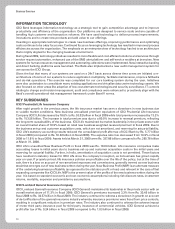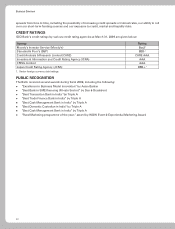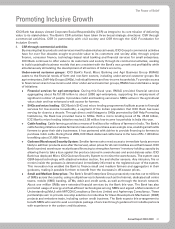ICICI Bank 2009 Annual Report Download - page 33
Download and view the complete annual report
Please find page 33 of the 2009 ICICI Bank annual report below. You can navigate through the pages in the report by either clicking on the pages listed below, or by using the keyword search tool below to find specific information within the annual report.
31Annual Report 2008-2009
The Power of Belief
for 22.3%, agriculture and allied activities for 11.9%, trade for 5.5%, real estate for 3.6% and other sectors for
the balance 15.0%. Total deposits grew by 19.8% during fiscal 2009 due to a 23.9% growth in time deposits
as demand deposits in the system declined by 0.8%. The credit-deposit ratio remained within the range of
71.0%-75.5% during fiscal 2009 and was about 72.0% in March 2009.
During fiscal 2009, volatile market and liquidity conditions and a moderation in demand for retail savings and
investment products had a negative impact on growth in the life insurance and mutual fund industries. First year
retail premium underwritten in the life insurance sector declined by 10.4% (on weighted received premium basis) to
Rs. 471.62 billion in fiscal 2009 with the private sector’s retail market share (on weighted received premium basis)
increasing from 50.5% in fiscal 2008 to 57.0% in fiscal 2009. Total assets under management (on average assets
basis) of mutual funds declined by 8.4% from Rs. 5,385.08 billion in March 2008 to Rs. 4,932.85 billion in March
2009. The non-life insurance industry was de-tariffed with effect from January 1, 2007 resulting in reduction in
premium rates and in the rate of growth of the industry. Gross premium in the non-life insurance sector (excluding
specialised insurance institutions) grew by 9.1% to Rs. 306.01 billion in fiscal 2009 compared to 12.3% in fiscal
2008 and 22.2% in fiscal 2007. The private sector’s market share in fiscal 2009 was 41.1%.
Equity markets remained weak on global macroeconomic concerns and a reversal in the pattern of global capital
flows. The BSE Sensex was 9,709 at March 31, 2009 compared to 15,644 at March 31, 2008. The Sensex recovered
to 12,173 at May 15, 2009 before rising sharply to 14,302 at May 19, 2009 following the announcement of the
results of the general elections.
There were a number of key policy developments in the banking sector during fiscal 2009. In April 2008, RBI issued
guidelines for banks engaging recovery agents, advising banks to put in place a grievance redressal mechanism
pertaining to the recovery process and a due diligence process for engaging recovery agents. In May 2008, RBI
issued a guideline whereby the shortfall in lending to weaker sections was also required to be taken into account
while determining contribution to the Rural Infrastructure Development Fund. In August 2008, RBI issued final
guidelines on prudential norms for off-balance sheet exposures requiring banks to treat unpaid amounts due for
90 days or more under derivative contracts as non-performing assets. Following the global financial crisis, RBI
has identified adequate credit flow at viable rates, maintaining credit quality, limiting the impact of adverse global
developments and price and financial stability as key monetary policy objectives. Since September 2008, RBI
significantly reduced key policy rates and reserve requirements for banks. Besides these, measures like additional
liquidity support through the Special Refinance Facility (upto 1% of net demand and time liabilities, or NDTL, for
a maximum period of 90 days) and a temporary relaxation in statutory liquidity ratio (SLR) maintenance of upto
1.5% of NDTL for lending to mutual funds and non-banking finance companies (NBFCs) were also introduced.
Interest rate ceilings on non resident Indian (NRI) deposits were increased, ECBs norms were relaxed and non-
deposit taking NBFCs were given permission to raise short-term foreign currency borrowings. RBI also reduced
risk weights on banks’ exposures to certain sectors as also provisioning requirements for standard assets as a
counter cyclical measure. RBI also permitted loans granted by banks to housing finance companies for on-lending
for housing upto Rs. 2.0 million per dwelling unit to be classified under priority sector lending. In December 2008,
RBI permitted commercial real estate exposures restructured upto June 30, 2009 to be treated as standard assets.
In addition, second restructuring by banks of exposures (excluding exposures to real estate, capital markets
and personal/consumer loans) up to June 30, 2009 was also made eligible for concessionary asset classification
treatment.
The Indian financial sector is healthy despite adverse developments in global markets. The Indian banking system
is well capitalised and well placed to manage any asset quality concerns. The financial sector in India is well placed
to capitalise on growth opportunities in our domestic markets.
ORGANISATION STRUCTURE
Our organisation structure is designed to be flexible and customer-focused. At the same time, we seek to ensure
effective control and supervision and consistency in standards across the organisation. The organisation is
structured into the following principal groups:
Retail Banking Group, comprising the retail liabilities, retail assets and small enterprises businesses.
Rural, Micro-banking and Agri-business Group, comprising the rural and agricultural lending and other banking
businesses.
Wholesale Banking Group, comprising the corporate & investment banking, commercial banking, project
finance and government banking businesses.
International Banking Group, comprising the Bank’s international operations, including operations in various
overseas markets as well as products and services for NRIs, international trade finance, correspondent banking
and wholesale resource mobilisation.



